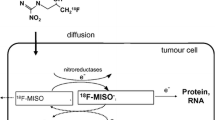Abstract
Gadolinium is the central metal that is used as magnetic resonance imaging (MRI) contrast media. Because the metal has toxicity on its own, it causes fibrosis or sclerosis of skin or internal organs, which may lead to disability in joint movement, or even death in the worst case. In the current study, the T 1 contrast media, Dotarem, was diluted to various molarities to measure the signal intensity of T 1-weighted images as a function of the molarity. The molarity that showed the maximum measurement value of the signal intensity was examined to determine the proper amount of contrast media injected for the MRI scan. The change in the intensity of the signal from the tumor tissue was determined based on the passage of time after injection. The distribution of the maximum signal intensities depending on the time to repeat showed that the signal distribution had >95% of the maximum values when the dilution concentration was in the range of 0.00095–0.00135 mmol/ml. Thus, it is most desirable when 0.084 mmol/kg (patient weight) of contrast media is injected. In experiments involving tumors 0.084, 0.1, and 0.15 mmol/kg were injected to measure the average signal intensity for each molarity. Compared to the signal intensity at a molarity of 0.084 mmol/kg, the three patient’s signal intensities were measured to increase by 6.2, 7.6, and 5.7% at a molarity of 0.1 mmol/kg, and by 21.4, 18.8, and 17.7% at a molarity of 0.15 mmol/kg. However, according to the correlation between the contract media injection amount and the signal intensity increase, the contrast effect was not improved much despite the increase in the injection amount by 19.04 and 78.5%. This study revealed that the optimal level of contrast media of 0.084 mmol/kg body weight should be administered by considering the body weight of patients and the effects of media to reduce side effects of a high dose of contrast media and to prevent environmental pollution.







Similar content being viewed by others
References
M. Rohrer, H. Bauer, J. Mintorovitch, M. Requardt, H.J. Weinmann, Invest. Radiol. 40, 714 (2005)
S.T. Cochran, K. Bomyea, J.W. Sayre, Am. J. Roentgenol. 176, 1385 (2001)
K.J. Murphy, J.A. Brunberg, R.H. Cohan, Am. J. Roentgenol. 167, 847 (1996)
J.T. Kim, J. Korean Ind. Eng. Chem. 19, 304 (2008)
N.H. Iris-Melanie, B.S. Ahmed, M. Vladimir, B. Markus, S. Alexander, H. Karl, M. Christian, F. Amura, K. Alexandra, T. Siegfried, Invest. Radiol. 37, 114 (2002)
J.R. Cameron, G.S. James, M.G. Roderick, Physics of the Body, 2nd edn. (Medical Physics, Madison, 1999), p. 182
D.S. Gierada, K.T. Bae, Radiology 210, 829 (1999)
R.C. Brasch, H.J. Weinmann, G.E. Wesbey, Am. J. Roentgenol. 142, 625 (1984)
U. Nyman, B. Elmstahl, P. Leander, M. Nilsson, K. Golman, T. Almen, Radiology 223, 311 (2002)
T. Albrecht, P. Dawson, Br. J. Radiol. 73, 878 (2002)
F.J. Palmer, Australas. Radiol. 32, 426 (1988)
R.J. Witte, L.L. Anzai, Am. J. Neuroradiol. 15, 523 (1994)
H.A. Goldstein, F.K. Kashanian, R.F. Blumetti, W.L. Holyoak, F.P. Hugo, Radiology 174, 17 (1990)
C.M. Nguyen, V.M. Haughton, K.C. Ho, H.S. An, Am. J. Neuroradiol. 14, 997 (1993)
D. Meyer, M. Schaefer, B. Bonnemain, Invest. Radiol. 23, S232 (1988)
J.O. Hoppe, A.A. Larsen, F. Coulston, J. Pharmacol. Exp. Ther. 116, 394 (1956)
H.S. Thomsen, S.K. Morcos, P. Dawson, Clin. Radiol. 61, 905 (2006)
Author information
Authors and Affiliations
Corresponding author
Rights and permissions
About this article
Cite this article
Yu, SM., Dong, KR., Ji, YS. et al. Signal Intensity for Contrast Enhancement as a Function of the Molarity of Gadolinium-Based MRI Contrast Media. Appl Magn Reson 40, 291–301 (2011). https://doi.org/10.1007/s00723-011-0201-0
Received:
Revised:
Published:
Issue Date:
DOI: https://doi.org/10.1007/s00723-011-0201-0




